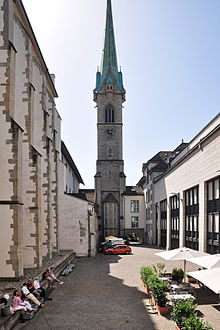Predigerkirche Zürich
| Predigerkirche | |
|---|---|

Predigerkirche to the left, the adjoint Zentralbibliothek to the right, the 96 metres (315 ft) high church tower in the middle
|
|
| Basic information | |
| Location |
Neumarkt, Zürich Switzerland |
| Geographic coordinates | 47°22′25.72″N 8°32′43.09″E / 47.3738111°N 8.5453028°E |
| Affiliation | Reformed |
| District | Evangelical Reformed Church of the Canton of Zürich |
| Website | Official website (German) |
| Architectural description | |
| Architect(s) | Friedrich Wehrli (church tower of 1900) |
| Architectural type | Church |
| Architectural style | Gothic Revival |
| Completed |
|
Predigerkirche is one of the four main churches of the old town of Zürich, Switzerland, besides Fraumünster, Grossmünster and St. Peter. First built in 1231 AD as a Romanesque church of the then Dominican Predigerkloster, the Basilica was converted in the first half of the 14th century, the choir between 1308 and 1350 rebuilt, and an for that time unusual high bell tower was built, regarded as most high Gothic edifice in Zürich.
Located nearby the medieval Neumarkt quarter, the commonly named Predigerkirche was mentioned for the first time in 1234 AD as the Predigerkloster monastery of the Dominican Order. The first Dominican monks settled, according to the chronicler Heinrich Brennwald, outside of the city walls of medieval Zürich at Stadelhofen in 1230, and the construction of a new convent in Zürich was first mentioned in 1231. Initially, against the resistance of the Grossmünster canons, the Dominican's inclusion in Zürich was granted in 1233/1235, because they tirelessly drove the little foxes in the vineyard of the Lord. The monastery consisted of a Romanesque church at the same place as today, and the monastic buildings built around the adjointed cloister to its west. In 1254 the establishment of a cemetery at Zähringerstrasse was allowed to the so-called "prayer" (used for Dominican monks, the 'blackfriars') abbey, and repealed in 1843. The order purchased 28 houses in the 13th and early 14th century, and was in close connection to the city nobility and landed gentry in Zürich and the surrounding area, among them the Bilgeri family (Grimmenturm) and the House of Rapperswil, where they received after their expulsion to 1348 asylum in Rapperswil. Memorial measurements had to be held until the 14th century at Grossmünster, because thus the most income was achieved. Until the Reformation in Zürich, all income obtained with the funerals had also to be delivered to the Grossmünster abbey. Within the city, as the other "mendicant" orders, the Dominicans have been reduced to the function of area pastors.
...
Wikipedia
